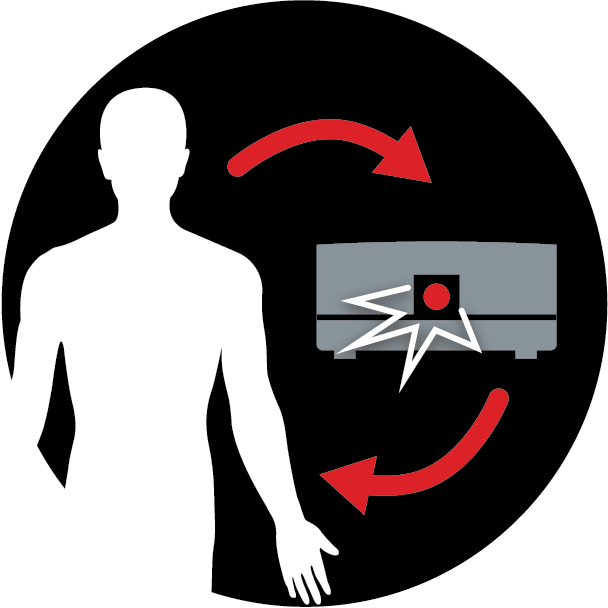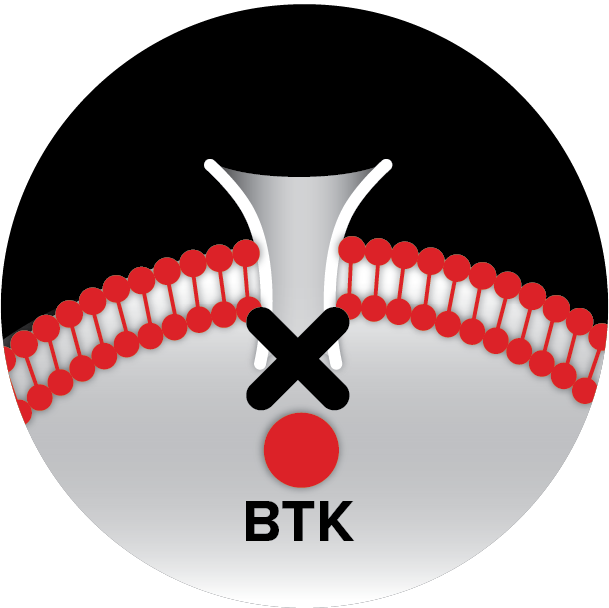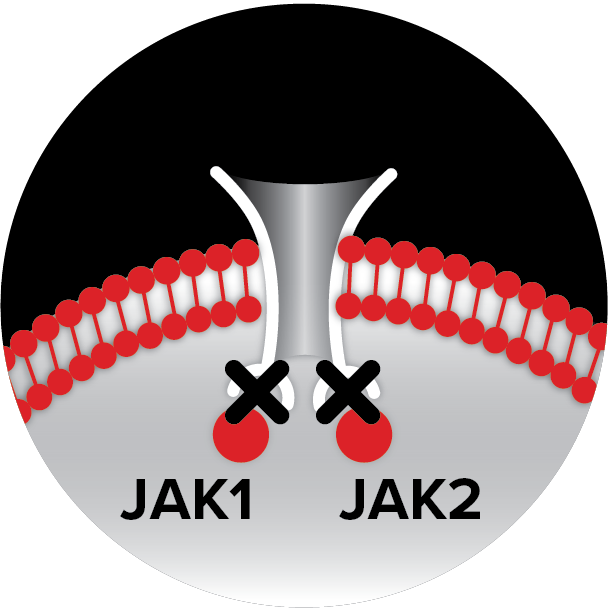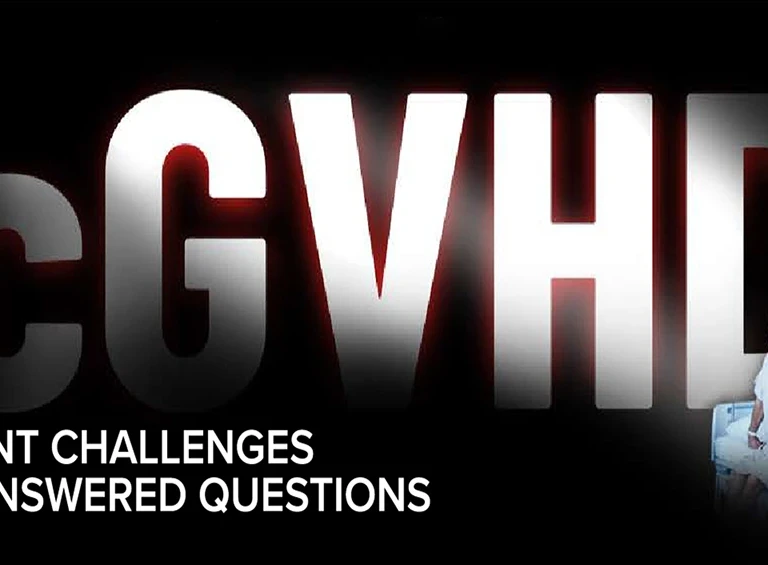{
event: "article_read",
name: `Other Treatment Options`,
author: ``,
tags: `Transplant`,
publication_date: ``,
interaction_type: "content"
}
.png)
ECP
.png)
BTK inhibitors
.png)
JAK inhibitors
Other Treatment Options
WHAT ARE OTHER TREATMENT OPTIONS?
There are several adjunctive options for the treatment of patients with chronic graft-versus-host disease, including targeted therapies and ECP. However, there is currently limited guidance regarding when each should be considered and for which patients these treatments will be most effective.1-4
.png)
ECP
ECP is a nonpharmacologic immunomodulatory therapy that involves leukapheresis of patient peripheral blood mononuclear cells, exposure of the cellular product to UV-A light in the presence of 8-methoxypsoralen and reinfusion of the ex vivo–treated cells.1
The mechanisms of ECP are not completely understood, although it is believed that ECP suppresses alloimmune responses by altering the maturation and function of dendritic cells, as well as through the induction of Treg cells.1 The procedure has shown benefit in patients with steroid-refractory cGVHD,1 as well as in those with skin, oral, and liver cGVHD.5
ECP requires venous or central access and involves a variety of treatment schedules to identify the appropriate dose intensity and length of treatment.6
The mechanisms of ECP are not completely understood, although it is believed that ECP suppresses alloimmune responses by altering the maturation and function of dendritic cells, as well as through the induction of Treg cells.1 The procedure has shown benefit in patients with steroid-refractory cGVHD,1 as well as in those with skin, oral, and liver cGVHD.5
ECP requires venous or central access and involves a variety of treatment schedules to identify the appropriate dose intensity and length of treatment.6
.png)
BTK inhibitors
BTK inhibitors form a covalent bond with a cysteine residue in the BTK active site, leading to inhibition of BTK enzymatic activity. Nonclinical studies have shown that this class of drug inhibits the proliferation and survival of malignant B cells in vivo, as well as cell migration and substrate adhesion in vitro.3 Some BTK inhibitors also inhibit IL-2–ITK, which is highly expressed in T cells and is closely related to BTK.1
Both B and T cells play important roles in the pathogenesis of cGVHD,7 and the inhibition of BTK and ITK has shown clinical benefit.1,7
Warnings and precautions associated with BTK inhibitors include infections and cytopenias, which include thrombocytopenia, neutropenia and anemia.3
Both B and T cells play important roles in the pathogenesis of cGVHD,7 and the inhibition of BTK and ITK has shown clinical benefit.1,7
Warnings and precautions associated with BTK inhibitors include infections and cytopenias, which include thrombocytopenia, neutropenia and anemia.3
.png)
JAK inhibitors
JAK1 and JAK2 mediate receptor signaling for a variety of pro-inflammatory cytokines, which are elevated in cGVHD.1
Inhibitors of this pathway have been shown to decrease expression of inflammatory cytokines and reduce GVHD in murine models,1,2 as well as suppress activation and differentiation of dendritic cells and T cells.1 This approach has shown promising results in patients with steroid-refractory cGVHD.1,8
Safety considerations associated with JAK inhibitors include monitoring for pruritus, infections, thrombocytopenia and leukopenia.8
Inhibitors of this pathway have been shown to decrease expression of inflammatory cytokines and reduce GVHD in murine models,1,2 as well as suppress activation and differentiation of dendritic cells and T cells.1 This approach has shown promising results in patients with steroid-refractory cGVHD.1,8
Safety considerations associated with JAK inhibitors include monitoring for pruritus, infections, thrombocytopenia and leukopenia.8
A greater number of treatments that address both the inflammatory and fibrotic processes of cGVHD are needed.
Are there new approaches to the treatment of cGVHD under clinical development?
BTK, Bruton's tyrosine kinase; cGVHD, chronic graft-versus-host disease; ECP, extracorporeal photopheresis; IL-2, interleukin 2; ITK, inducible kinase; JAK, Janus-associated kinase.
- Cutler CS, Koreth J, Ritz J. Mechanistic approaches for the prevention and treatment of chronic GVHD. Blood. 2017;129(1):22-29. doi:10.1182/blood-2016-08-686659
- Jakafi. Package insert. Incyte Corporation; 2021.
- Imbruvica. Package insert. Pharmacyclics LLC; 2022.
- Hamilton BK. Updates in chronic graft-versus-host disease. Hematology Am Soc Hematol Educ Program. 2021;2021(1):648-654. doi:10.1182/hematology.2021000301
- Afram G, Watz E, Remberger M, et al. Higher response rates in patients with severe chronic skin graft-versus-host disease treated with extracorporeal photopheresis. Cent Eur J Immunol. 2019;44(1):84-91. doi:10.5114/ceji.2018.75831
- Wolff D, Schleuning M, von Harsdorf S, et al. Consensus Conference on Clinical Practice in Chronic GVHD: second-line treatment of chronic graft-versus-host disease. Biol Blood Marrow Transplant. 2011;17(1):1-17. doi:10.1016/j.bbmt.2010.05.011
- Miklos D, Cutler CS, Arora M, et al. Ibrutinib for chronic graft-versus-host disease after failure of prior therapy. Blood. 2017;130(21):2243-2250. doi:10.1182/blood-2017-07-793786
- Modi B, Hernandez-Henderson M, Yang D, et al. Ruxolitinib as salvage therapy for chronic graft-versus-host disease. Biol Blood Marrow Transplant. 2019;25(2):265-269. doi:10.1016/j.bbmt.2018.09.003
MAT-SA-2300860/v2/March2024

